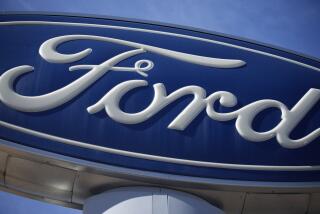Tracing Pickup Truck’s Journey From Factory to Farm to Suburbia
- Share via
In this affectionate history, Lukach traces the development of the pickup from 1900, when Henry Ford was working with the infant and ill-fated Detroit Automobile Co. that introduced its Delivery Wagon, a lightweight commercial hauling vehicle that sold for the then-considerable sum of $710.
It was a truck. It picked things up. Although he didn’t coin it, Ford popularized the term “pickup truck” through constant usage.
In 1925, with his Ford Motor Co. selling a million vehicles a year, Ford introduced the first mass-produced pickup: the Model T “Runabout With a Pick-Up Body.” Three years later, Ford Motor was selling 10,000 Runabouts a year, and the price had dropped to $281.
Earlier pickups had been hybrids. The chassis and cab were made by the car manufacturer. The dealer (or purchaser) added a pickup bed made by another company, such as Martin-Parry, Superior, Fruehauf and Hercules.
Dodge followed Ford’s example, entering the market in 1927 with a factory-built three-quarter-ton truck that offered a four-cylinder, 35-horsepower engine. Chevrolet introduced trucks with its legendary “stove bolt” six-cylinder engine in 1929.
Although Lukach concentrates on what was then the Big Three, he also celebrates the trucks produced by smaller, independent companies: Reo, Mack, Willys-Overland, Diamond-T, Buddy Stewart. He praises the Hudson Terraplane, which was manufactured only briefly, from 1934 to ‘37, as “quite possibly the most beautiful truck ever made.”
With its minimal chrome, fan-like grille and distinctively curved front bumper, the Terraplane embodies the Art Deco elegance of the ‘30s. It’s easier to imagine Joan Crawford stepping out of one in fox furs and sling-back pumps than a farmer in overalls using it to deliver hay.
The post-World War II boom produced what Lukach argues are the most successful designs for pickups. The combination of streamlining and squarer proportions suggests an appealing mixture of strength and functionality. The unbroken curves, egg-crate grille and overall feeling of restrained power of the 1956 Chevy Task Force represent a high point in postwar styling few contemporary vehicles can match.
The mid-’50s also produced some aberrations: The 1957 Dodge Sweptside, which featured two-tone fins taken from the company’s station wagon, exhibits a maladroit clunkiness only a serious collector could love.
As the number of farmers in America declined during the ‘50s and ‘60s, the pickup was gradually transformed from a rural working truck to a suburban recreational vehicle. This significant change in use and image was aided by an exemption from the “gas-guzzler” taxes aimed at large passenger vehicles. Although Lukach notes this shift, he fails to discuss why suburbanites decided they needed a three-quarter-ton, all-terrain sport-utility vehicle with four-wheel drive for trips to the mall.
The outsize format (14 inches square) of “Pickup Trucks” allows Lukach to showcase old advertisements and large photographs of trucks, including lovingly restored classics--many in better condition than when they rolled off the assembly line. Unfortunately, the format also makes the book uncomfortable to hold and read.
*
Highway 1 contributor Charles Solomon can be reached via e-mail at highway1@latimes.com.
As the number of farmers in America declined during the ‘50s and ‘60s, the pickup was gradually transformed from a rural working truck to a suburban recreational vehicle.






